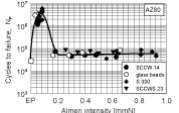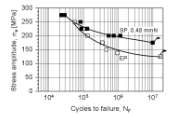E-Archive
Science Update
in Vol. 3 - May Issue - Year 2002
Response of Light Alloys to Shot Peening: Comparison of Magnesium and Aluminum Alloys

Prof. Lothar Wagner, Shot Peener of the Year 2000, holds the Chair of Physical Metallurgy and Materials Technology at the Technical University of Brandenburg at Cottbus. He is Chairman of ICSP8 to be held in Garmisch-Partenkirchen, 16-20 September 2002.

Figure 1. Fatigue life (R = -1) vs. Almen intensity in AZ80 a = 175 MPA

Figure 2. Fatigue life (R = -1) vs. Almen intensity in 6082 Al (a = 200 MPa)

Figure 3. Subsurface fatigue crack nucleation (SEM) in AZ80

a) AZ80

b) 6082 Al

b) 6082 Al Figure 4. S-N curves in magnesium and aluminum alloys: Effect of optimum shot peening
Lothar Wagner, Chair of Physical Metallurgy and Materials TechnologyTechnical University of Brandenburg at Cottbus, Germany
The effect of shot peening on the HCF behavior in the light-metal alloys 6082 Al and the magnesium alloy AZ80 was studied. The response of the magnesium alloy to shot peening depended strongly on Almen intensity in that pronounced lifetime improvements were observed only in a range of very low Almen intensities. Higher intensities led to marked overpeening effects. In contrast, the aluminum alloy showed no loss in lifetime with increasing Almen intensity. It is argued that the shot peening-induced high surface roughness and microcracks are the main reason for the marked sensitivity of the magnesium alloy to Almen intensity in shot peening.
Introduction
Mechanical surface treatments such as shot peening, roller-burnishing and deep-rolling are known to improve the fatigue performance of structural metallic materials such as steels and titanium alloys. Depending on the particular surface treatment and material, this improvement derives mainly from process-induced increases in dislocation density, i.e., work hardening or from residual compressive stresses which can significantly retard microcrack growth (e.g., 1-4). While the effect of mechanical surface treatments on the fatigue performance of steels and titanium alloys is well documented in the literature, there is little information on the influence of mechanical surface treatments on fatigue behavior of magnesium alloys. Since the application of magnesium alloys is expected to substantially increase in this decade owing to the potential reduction in weight for many structural parts (5), experimental data regarding suitable process parameters for mechanical surface treatments are needed. In the present investigation, the process parameters for shot peening for optimum fatigue life improvements of the high-strength magnesium alloy AZ 80 were studied and compared with 6082 Al.
Experimental
The magnesium alloy AZ80 (nominal composition: 8 Al, 0.5 Zn, 0.2 Mn, balance: Mg) and the aluminum alloy 6082 Al (nominal composition: 1 Mg, 1 Si, 0.6 Mn, balance Al) were received as extrusions from Otto Fuchs Metallwerke, Meinerzhagen, Germany. The rectangular bars had cross sections of 110 x 70 mm and 85 x 25 mm for AZ80 and 6082 Al, respectively. AZ80 was tested in the as-fabricated condition, while 6082 Al had been given a T6 temper.
Tensile and fatigue tests were performed in extrusion (L) direction.
Table 1. Tensile test results on AZ80 and 6082 Al-T6
For fatigue testing, hour-glass shaped round specimens (5 mm gage diameter) were machined. After machining, about 200 mm was removed from the surface of the specimens by electrolytical polishing (EP) to ensure that any machining effect that could mask the results was absent.
Shot peening (SP) was performed with an injector type machine using various shot materials, e.g., SCCW14, SCCWS23, S330 and glass beads. The Almen intensity was varied between 0.03 and 0.63 mmN. Fatigue tests were performed in rotating beam loading (R=-1) in air at frequencies of about 60 Hz.
Results and Discussion
The effect of shot material and Almen intensity on fatigue life of the two light metal alloys is illustrated in Figs. 1 and 2. Starting with the reference EP, the fatigue life in AZ80 (Fig. 1) at a stress amplitude of 175 MPa first dramatically increases by roughly two orders of magnitude, irrespective of the particular peening medium, then drops drastically as peening intensity increases.
Unlike the situation in the magnesium alloy, no overpeening effect was found in Al 6082 (Fig. 2). Instead, there is a gradual increase in fatigue life with Almen intensity until saturation occurs.
As seen in Fig. 3, subsurface fatigue crack nucleation in AZ80 was found under optimum peening conditions, while the fatigue cracks nucleated at the surface not only in the reference EP but also after peening with higher Almen intensities.
No subsurface fatigue crack nucleation sites were observed in shot peened 6082 Al, irrespective of Almen intensity used.
The S-N curves in AZ80 (Fig. 4a) confirm the marked effect that the Almen intensity has on fatigue life. The HCF-behavior of the heavily (0.40 mmN) peened is clearly inferior to the lightly (0.05 mmN) peened specimens. Optimum peening of 6082 Al clearly increases the HCF strength, while fatigue life at high stress amplitudes is hardly improved (Fig. 4b).
Comparing the effect of optimum shot peening on fatigue performance between the two light metal alloys (Fig. 4), the response of AZ80 is clearly superior to that of 6082 Al (Fig. 4, compare 4a with 4b). From (6) it is known that AZ80 shows cyclic hardening, while cyclic softening is observed in 6082 Al as is typical for the T6 temper. Therefore, the different response to shot peening is presumably caused by differences in cyclic stability of process induced residual compressive stresses retarding microcrack growth.
The author would like to thank Otto Fuchs Metallwerke, Meinerzhagen, Germany, for providing the magnesium and aluminum alloys.
References
1. C. H. Burck, C. P. Sullivan and C. H. Wells, Met. Trans. 1A, 1970, 1595.
2. M. S. Baxa, Y. A. Chang, C. H. Burck, Met. Trans. 9A, 1979, 656.
3.J. E. Hack, G. R. Leverant, Residual Stress Effects in Fatigue, ASTM STP 776, 1982, 204.
4. H. Gray, L. Wagner, G. Lütjering, Residual Stresses in Science and Technology, DGM, 1987, 815.
5. T. K. Aune and H. Westengen, Magnesium Alloys and their Applications (B. L. Mordike, and F. Hehmann, eds.) DGM (1992), 221.
6.M. Hilpert and L. Wagner, Magnesium Alloys and their Applications (B. L. Mordike and K. U. Kainer, eds.), MAT INFO (1998), 271.
BTU Cottbus
Tel: +49.355.69 28 15
E-mail: wagner@tu-cottbus.de



























